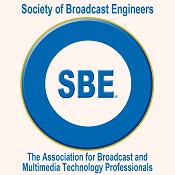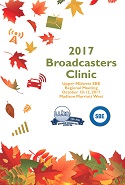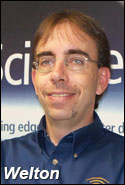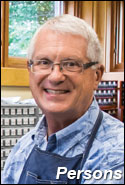
|

CHAPTER 24, Inc., MADISON, WI
|
|
Monthly eNews
|
August 2018
|
Our Next Chapter Meeting
August 23rd
Videstra Live Cams
Dan Desjardins will discuss the technology of camera streaming, including what to do and what not to do based on experience. The program will include a live demonstration of the VestraView live camera system.
Dutch treat dinner at 5:30 pm
Culvers
2102 W. Beltline Hwy
Madison, WI
Meeting and program at 7:00 pm
Wis Public Broadcast Center (ECB)
3319 W. Beltline Hwy
Madison, WI
Directions Here
Visitors and guests are welcome!
Meeting Minutes
Submitted by Mike Norton, Secretary
July, 2018
The Society of Broadcast Engineers Chapter 24 monthly meeting was held on Wednesday, July 25, 2018 at the Sun Prairie Media Center. There were 13 members present, 9 who held SBE certification, and 2 guests.
Chapter Chair Rich Wood called the meeting to order at 7:02pm. No changes or additions to the June meeting minutes were brought up, so on a motion by Pete Deets and a second by Leonard Charles they were approved as posted on the Chapter 24 eNews page.
Treasurer Roy Henn reported a SBE National rebate check was deposited in the Chapter 24 account. A gift card for outgoing newsletter editor Paul Stoffel was the most recent expenditure. The Chapter finances continue to maintain a positive balance. (approx $6000)
Leonard Charles noted that the deadline for the Chapter 24 eNews page on the website is the first of the month. Email articles or items of interest to lcharles@sbe.org.
Rich Wood gave a membership update stating there are 46 current members, and 15 sustaining member companies. Two recent sustaining membership renewals were received from Clark Wire & Cable and The Mink Company.
Rich reviewed the upcoming schedule, starting with the Thursday, August 23 program on Videstra live cameras at the Wisconsin Public Broadcasting Center. Bob Orban will give a talk about TV audio processing on September 26, and the October 17 meeting at the Broadcast Clinic will cover air vs liquid cooling for transmitters.
Jim Hermanson gave a Certification and Education update, listing the next local exam window as November 2-12 with an application deadline of September 24. He also congratulated Pete Deets from WMTV and Andrew Kennedy from WISC on their recent re-certifications.
For frequency coordination, Tom Smith reported that he received a 450MHz coordination request for the CrossFit Games in Madison. The CrossFit Games event runs August 1-5 at the Alliant Energy Center.
Leonard Charles gave a SBE National report, starting with the SBE annual elections that are underway. Members should have received a unique email link to the voting site, while those who opted-out of electronic voting should receive paper ballots via US Mail. Voting closes at 4:30pm EDT on August 22, 2018. A webinar titled RF 201: Module 2: FM Antenna Systems will happen Thursday July 26 at 1:00pm; register at the SBE.org web site. The SBE Compensation Survey results are available to SBE members; see the SBE.org web site to access the report.
Rich Wood mentioned that the SBE National has inquired about holding its 2019 SBE National Meeting at the Broadcast Clinic. There was no old business brought up. For new business, Rich Wood proposed using SBE Chapter 24 funds to sponsor the Tuesday Nuts & Bolts session beer and brat dinner at the upcoming 2018 Broadcast Clinic. Expenditures over $300 require approval by membership, with 10 percent of registered member required for a quorum. The cost for the dinner sponsorship is $1500. A vote was taken and the proposal passed. Following the vote, concerns were raised about the impact on the chapter account if the sponsorship was repeated at following Broadcast Clinic events. Rich indicated this would be a one-time expense.
The meeting was adjourned at 7:20pm. Tom Smith shared an update on the FCC C-Band satellite antenna registration process and the FCC report and order to collect additional information. Jeff Robbins from the Sun Prairie Media Center then gave a tour of the television facility and WLSP-LP radio studio. Jeff also gave a presentation on the background and operation of the Sun Prairie Media Center.
Congratulations!
2018 SBE National Award winners.

Best Chapter Regional Educational Event; The 2017 Broadcasters Clinic

James C. Wulliman SBE Edujcator of the Year; Jeff Welton, CBRE, Nautel

Robert W. Flanders SBE Engineer of the Year; Mark Person, CPBE, AMD, CBNT, Chapter 17 (MSP)
Click Here for a rundown of all 2018 SBE National Awards.
2018 Broadcasters Clinic Agenda Released
Early Bird registration is now open for the 2018 Broadcasters Clinic. The event will be held October 16th thru 18th at the Madison Marriott West. Enter the dates in your scheduler now and book your seat.
Session Agenda
On-Line Registration.
Amateur Radio News
compiled by Tom Weeden WJ9H
One of ham radio's newest and most popular digital modes, FT8, is about to be upgraded to version 2.0 early in 2019. The suite of weak-signal digital protocols known as WSJT-X, which includes FT8, will include major changes, according to co-developer Joe Taylor, K1JT. The various protocols are optimized for low-speed, reliable communications in different parts of the spectrum, anywhere from low and medium frequencies to UHF and microwave under extremely weak-signal conditions, including reflecting signals off the moon and ionized meteor trails. An introduction to the various WSJT-X modes is here.
The FCC has issued a Notice of Apparent Liability (NAL) proposing to fine Jerry W. Materne, KC5CSG, of Lake Charles, Louisiana, $18,000 "for apparently causing intentional interference and for apparently failing to provide station identification on amateur radio frequencies," the FCC said.
"Mr. Materne was previously warned regarding this behavior in writing by the Enforcement Bureau and, given his history as a repeat offender, these apparent violations warrant a significant penalty," the FCC said in the NAL, released on July 25.
In 2017, the FCC received numerous complaints alleging that Materne was causing interference to the W5BII repeater, preventing other amateur licensees from using it. In March 2017, the repeater trustee banned Materne from using the repeater.
Responding to some of the complaints, the Enforcement Bureau issued a Letter of Inquiry (LOI), advising Materne of the allegations and directing him to address them. Materne denied causing interference but admitted to operating simplex on the repeater's output frequency. In June 2017, the FCC received an additional complaint alleging that Materne had repeatedly interfered with an attempted emergency net that was called up as Tropical Storm Cindy was about to make landfall. The complaint maintained that Materne "repeatedly transmitted on the repeater's input frequency, hindering the local emergency net's ability to coordinate weather warnings and alerts on behalf of the National Weather Service," the FCC said in the NAL.
Local amateurs were able to track the interfering signal to Materne's residence and confirmed their findings to the FCC, prompting a Warning Letter advising Materne of the complaint and pointing out that his behavior "as described in the complaint would be a violation of Section 97.101(d) of the Commission's rules." Materne responded to the Warning Letter to argue that it was legal to transmit on the repeater's output frequency, further stating that "he was tired of this trash harassing me," the FCC said.
In the wake of further complaints, FCC agents visited Lake Charles, tracked transmissions on 146.130 MHz to Materne's residence, and monitored them for up to 7 hours. The agent reported hearing Materne "playing music on 146.130 MHz and warning other amateur operators that the local Amateur Radio club would not be able to conduct their net later that day."
That evening, the agent watched as Materne drove to a location near the W5BII repeater, where, the agent said, Materne "began transmitting an amateur digital radio signal from a hand-held radio in his vehicle," disrupting the net and failing to identify. Subsequently, the agent, accompanied by a deputy from the Calcasieu Parish Sheriff's Office, approached Materne's vehicle and confirmed that he possessed a radio capable of operating on 146.130 MHz. "Audio recordings captured by the agent demonstrate that the intentional interference ceased as the agent and the Sheriff's deputy approached Mr. Materne's vehicle," the FCC said in the NAL.
"[W]e find that Mr. Materne's apparent repeated, intentional, and egregious apparent violations of Section 333 of the Act and Section 97.101(d) of the Commission's rules warrant an upward adjustment of $10,000 to the proposed forfeiture," the FCC said. "In applying the applicable statutory factors, we also consider whether there is any basis for a downward adjustment of the proposed forfeiture. Here, we find none."
The US House of Representatives is considering a bill, HR 5709, known as "The PIRATE Act" (Preventing Illegal Radio Abuse Through Enforcement Act). HR 5709 seeks to raise penalties for illegal broadcasting to as much as $100,000 per day, and directs the FCC to conduct monitoring and annual sweeps for illegal activity "within the top five radio markets identified as prevalent for such broadcasts." The bill defines "pirate radio broadcasting" as transmission of communications between 535-1705 kHz or 87.7-108 MHz without an FCC license, but does not include unlicensed operations in compliance with Part 15 of FCC Rules. The text of the bill can be found here.
(Excerpts from the American Radio Relay League's arrl.org web site)
FCC NEWS
compiled by Tom Smith
C-BAND RULEMAKING
On July 12th, the FCC adopted a Notice of Final Rulemaking and a Notice of Proposed Rulemaking (FCC-18-91A1) on the proposal of sharing of the 3.7 to 4.2 GHz band for satellite downlinks and point to multi-point broadband service with mobile operations. They are proposing that all of the 500 MHz of the band be shared. SES and Intelstat satellite systems have made a counter proposal calling for reallocating the lower 100 MHz of the 3.7 to 4.2 band for terrestrial mobile broadband use. In the Notice of Final Rulemaking, the FCC adopted rules requiring operators of satellite earth stations (receive or downlink sites) and satellite space stations (the actual satellites) to certify their information. In this Order, the FCC requires that all existing registered or licensed earth stations as of April 19, 2018 must certify their registration accuracy. Those earth stations that are registered between April 19, 2018 and October 17, 2018 will not have to recertify. This includes all mobile earth stations. Mobile earth stations must include the following information:
- earth station call sign (or IBFS file number if a registration filed between April 19, 2018 and October 17, 2018, is pending)
- geographic location where the equipment is typically stored
- the area within which the equipment is typically used
- how often the equipment is used and the duration of such use (i.e., please provide examples of typical deployments, e.g., operation x days a week at sports arenas within a radius of y miles of its home base)
- number of transponders typically used in the 3.7-4.2 GHz band and extent of use on both the uplink and downlink
- licensee/registrant and point of contact information
Operators of satellite space stations will have to file the following information:
- satellite call sign, name, and orbital location
- expected end-of-life for satellite
- the approximate dates that any additional C-band satellites with a currently pending application in IBFS are planned for launch to serve the United States market (note whether this satellite is a replacement)
- whether any additional C-band satellites that do not have a currently pending application in IBFS are planned for launch to serve the United States market and the approximate date of such launch (note whether this satellite is a replacement)
- for each transponder operating in the 3.7-4.2 GHz range that is operational and legally authorized to serve customers in the United States, for the most recent month, provide the following:
- the frequency range of transponder and transponder number
- the capacity in terms of the number of megahertz on each transponder that are currently under contract (also provide this data for one month in 2016)
- For each day in the most recent month, please provide the percentage of each transponder's capacity (megahertz) utilized and the maximum capacity utilized on
that day. (Parties should use the most recent month of data and provide the date range at which the data was collected; they may also supplement the data with
historical trend data over recent months up to three years if they feel it displays utilization variances)
- the center frequency and bandwidth of the Telemetry Tracking and Command beam(s)
- the call sign and geographic location (using NAD83 coordinates) of each TT&C receive site.
The FCC is going to use this information on transponder usage in order to determine if either the lower or upper part of the band can be freed up for broadband use if the whole 500 MHz is not available.
The offices of the International Bureau, the Wireless Bureau and the Office of Engineering and Technology will issue a Notice detailing the required information that will be needed to be filed.
In the Notice of Proposed Rulemaking, a number of issues are covered, two of the subjects are the technical standards and the possible methods of auctioning the new terrestrial broadband licenses. These proposed rules will be determined in part by the information on current satellite downlink usage and the amount of useable spectrum. The proposed rulemakings that affect existing users are the main interest at this moment. In a section of the notice called Future of the Incumbent Usage of the 3.7 to 4.2 GHz Band, a number of points were raised. They include the protection of existing earth stations, the freezing of any new registrations of earth stations including the moving of existing earth stations. The proposed rules would also remove protection of existing earth stations that were registered or licensed before April 19, 2018 that do not recertify. Other proposals include updating information and coordinating spectrum usage of registered earth stations and a proposal for the information that earth station operators must provide. The information that the FCC proposes to collect follows:
- earth station call sign
- geographic location
- licensee and point of contact information
- antenna gain
- azimuth and elevation gain pattern
- antenna azimuth relative to true north
- antenna elevation angle
- satellite(s) at which the earth station is pointed
- transponder number(s) and how often each transponder is used: regularly (i.e., at least daily); infrequently; or backup capacity
- antenna site elevation and height above ground
Note that the information that may be collect requires the specific satellites and transponders that each dish looks at and if not 24/7, but the times that they are used. This would indicate that the wireless broadband providers would interweave their spectrum usage between the channels used by the downlinks. They also want information on the locations of mobile up link usage and the satellites and transponders used. The satellite operator SES in their filing instructions still suggest that those registering their dishes file for the full arc from 60 degrees East to 143 degrees West. Since the FCC is only proposing to have information for specific satellites and transponders, it should still be permissible to file for full arc protection.
Also frozen would be the licensing on any new satellite operators and only allowing any new satellites that are not currently launched or authorized for construction or launch if it would allow for more efficient spectrum usage in the C-Band. Other issues discussed the sun setting of any remaining fixed point to point common carrier systems and the possible usage of the band for broadband use. There was also discussion of using market forces for clearing the band of satellite services.
This Proposed rulemaking could be considered a plan that would result in the slow death of the use of the 3.7 to 4.2 GHz spectrum for the use of satellite downlink service.
NEW CHILDERNS TV RULES
The FCC adopted a Notice of Proposed Rulemaking (FCC-18-93A1) concerning children's TV rules. The proposed rules would require stations to air three hours of children's TV programming on anyone of its free channels. Stations would not be required to air the programming on its main channel, but would then have to air the children's programming on one of their sub channels and would not be required to air children's programming on all of its sub channels, The other proposed rule change would be reducing the requirement to file the Children's report to once a year and to be filed within 10 days of the first of the year.
See last month's newsletter for the list of other items discussed in the notice and may be covered in future rulemakings.
NEW FM STATION CLASS
On June 4th, the FCC issued a Notice of Inquiry (FCC-18-69A1) proposing a new class of FM stations and an updating the rules concerning the short spacing of FM stations. The new class of FM stations would be class C4 which would operate at 300 meters with 12 kilowatts. The proposed stations would be allocated in Zone 2 with covers most southern states, northern Michigan and Wisconsin and west of the Mississippi except part of California. They must operate with a power level greater than the Class A power level of 6 kw. Class C3 stations minimum power will be increased greater than 12 kw from 6 kw. There was no discussion of spacing requirements. The second part of the Inquiry was changes in the rules for the short-spacing of FM stations. The proposal is to allow protection to a stations signal contour instead of the standard mileage separation requirement for that stations class of operation. If a station has operated with less than maximum facilities for 10 years of more, then a new proposed allocation could use the existing contour as reference for protection to the existing station. The existing station would be given a 30 day period to propose an upgrading of its facility and than a 180 day deadline to file a application for a construction permit to upgrade. Stations in the reserved band (channels 200-219) already use stations contours for allocation purposes.
Comments are due on August 13th and replies are due on September 10th.
FCC SEEKS COMMENT ON AUDIO COMPETITION
On July 23rd, the FCC issued a Public Notice (DA-18-761A1) asking for comment on the state of audio competition including that of broadcast and satellite radio and over the internet and mobile devices. They listed the following discussion points:
- identification and ownership of key Audio Marketplace Participants, as well as the business models and competitive strategies they use
- trends in service offerings, pricing, and consumer behavior
- the extent of competition among Audio Marketplace Participants, including intramodal competition (i.e., competition among providers of the same type, such as terrestrial radio broadcast stations) and intermodal competition (i.e., competition among providers of different types, such as terrestrial radio broadcast stations and satellite radio providers)
- ratings, subscribership, and revenue information, for the marketplace as a whole and for individual Audio Marketplace Participants
- capital investment, innovation, and the deployment of advanced technology
- requirements for entry into the marketplace
- recent entry into and exit from the marketplace
They asked for information based on information, data and statistics from the last two years. There will be 30 day comment period with a 15 day reply period.
NATIONAL EAS TEST SCHEDULED
The FCC has scheduled an National EAS test (DA-18-754A1) on September 20th with a backup date of October 3rd. ETRS Form One will have to be filed by August 27th and From Two by November 5th.
EEO ENFORCEMENT MOVED
On July 24th, the FCC issued an Order (FCC-18-103A1) that moved the enforcement of the EEO rules from the Media bureau to the Enforcement Bureau. This was at the request of a number of civil rights groups. This rule change affects all TV and radio stations and cable and satellite TV and radio providers. They did not give a date the action would take effect.
OLDEST RADIO-TV COMBO SPLITS
Wisconsin's oldest radio-TV combination is about to be split up. WTMJ radio and TV are about to be split as the owner of the stations Scripps's is selling WTMJ-AM 620 and FM station WKTI 94.5 to Good Karma Brands for 16 million dollars. They announced in January of this year that they were planning to sell their 34 radio stations that they acquired when they purchased the Journal Group. WTMJ-AM is one of the oldest radio stations in the state of Wisconsin and WTMJ-TV is the oldest TV station in Wisconsin. The two stations have been operated together by the Journal Company and then Scripps's for 70 years. They were the only remaining radio-TV combination in the state. Good Karma Brands operates an AM and a FM station in Beaver Dam which was their first stations in the group. They own a FM in Madison and an AM in the Milwaukee area which form ESPN Wisconsin. They also have an AM station licensed to Columbus, WI and two AM stations in Cleveland, Ohio and two stations in Florida. Here is a link to the Scripps's press release.
Certification and Education
compiled by Jim Hermanson
The Open 2018 Exam Schedule
| Exam Dates |
Location |
Application Deadline |
| November 2-12, 2018 |
Local Chapters (Madison Area) |
September 24, 2018 |
When you are ready to take an SBE exam, please fill out the appropriate application and send it into the SBE National office (see address below). You will be notified once your application has been approved. Approximately 3 weeks before the exam time, your local certification chairman will receive a list of applicants in his/her area. He/she will then contact those applicants to schedule a date, time and place for the exams. The exams will be mailed back to the National office for grading. The pass/fail grades will then be mailed directly to the applicants.
You may mail, email or fax your applications to:
Megan E. Clappe
Certification Director
9102 N. Meridian St., Suite 150
Indianapolis, IN 46260
317-846-9120 Fax
mclappe@sbe.org
|
Views expressed herein do not necessarily reflect the official position of the Society of Broadcast Engineers (SBE), its officers, or its members. SBE Chapter 24, Inc. regrets, but is not liable for, any omissions or errors.
|




